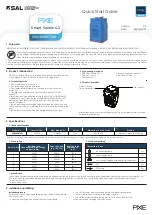
IFS NS3502-8P-2S User Manual
543
Line Detection
Before power is applied, safety dictates that it must first be ensured that a valid PD is connected to the
PSE's output. This process is referred to as "line detection", and involves the PSE seeking a specific, 25
KΩ signature resistor. Detection of this signature indicates that a valid PD is connected, and that
provision of power to the device may commence.
The signature resistor lies in the PD's PoE front-end, isolated from the rest of the PD's circuitries till
detection is certified.
Classification
Once a PD is detected, the PSE may optionally perform classification, to determine the maximal power
a PD is to consume. The PSE induces 15.5-20.5 VDC, limited to 100 mA, for a period of 10 to 75 ms
responded by a certain current consumption by the PD, indicating its power class.
The PD is assigned to one of 5 classes: 0 (default class) indicates that full 15.4 watts should be provided,
1-3 indicate various required power levels and 4 is reserved for future use. PDs that do not support
classification are assigned to class 0. Special care must be employed in the definition of class
thresholds, as classification may be affected by cable losses.
Classifying a PD according to its power consumption may assist a PoE system in optimizing its power
distribution. Such a system typically suffers from lack of power resources, so that efficient power
management based on classification results may reduce total system costs.
Start-up
Once line detection and optional classification stages are completed, the PSE must switch from low
voltage to its full voltage capacity (44-57 Volts) over a minimal amount of time (above 15
microseconds).
A gradual startup is required, as a sudden rise in voltage (reaching high frequencies) would introduce
noise on the data lines.
Once provision of power is initiated, it is common for inrush current to be experienced at the PSE port,
due to the PD’s input capacitance. A PD must be designed to cease inrush current consumption (of over
350 mA) within 50 ms of power provision startup.
Operation
During normal operation, the PSE provides 44-57 VDC, able to support a minimum of 15.4 watts power.
Power Overload
s
The IEEE 802.3af standard defines handling of overload conditions. In the event of an overload (a PD
drawing a higher power level than the allowed 12.95 Watts), or an outright short circuit caused by a
failure in cabling or in the PD, the PSE must shut down power within 50 to 75 milliseconds, while
limiting current drain during this period to protect the cabling infrastructure. Immediate voltage drop is
avoided to prevent shutdown due to random fluctuations.
















































